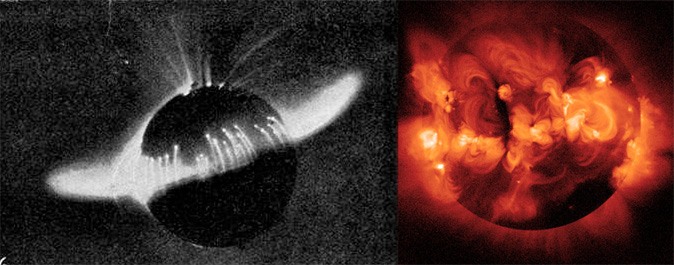The big deal is the stupidity of comparing an image that is supposed to be Saturn with an image that is the Sun.
According to Birkeland himself it *WAS SUPPOSED TO REPRESENT THE SUN AND THE CORONA!*. You can of course accuse Birkeland of being stupid, but he personally equated these events to solar coronal activity. I really get the impression that you're young and "winging it" as it relates to Birkeland's actual writings. How could anyone miss the fact he equated all of these events to solar activity?
The big deal is the stupidity of thinking that comparing images is valid science.
Oh the ignorance of that statement. How else did you expect us to falsify or verify any theory?
Things that look alike need not be alike.
And sometimes they are *EXACTLY* alike. How do we know which of these statements is true?
The big deal is the stupidity
A fifteen year old might continue to resort to childish insults, but you really aren't doing yourself any favors as you will learn when you finally grow up. That's twice now you've called someone (evidently Birkeland/yourself the first time) in this post and we're only like three paragraphs in. I smell fear now.
of thinking that visible light images look exactly like X-ray images.
That is a "strawman". I never said they were "exactly" alike, but they can and do follow the same patterns in nature, and electrical discharges have been shown to emit photons up to the energy state of gamma rays.
Any intellegent person would compare Birkeland's image with an image in visible light.
No. Any intelligent individual would scale the thing to size.
The fact that you did not shows that you are cherry picking the images. Which leads to...
No, you're cherry picking the images by refusing to look at, comment on or even acknowledge the images I have cited.
The big deal is that there are many images of the Sun that do not look like Birkeland's image of Saturn.
Birkeland knew enough to scale his model, and he himself said it looked like the sun's corona, not Saturn.. Either you didn't read the material at all (which seems likely after your "solid globe" blunder), or you simply misread his statements. I didn't compare that image to the sun, he did. He did not compare it to Saturn, he specifically compared it to *SOLAR* events.
You really need to do your homework, watch the images I have suggested, read the materials I have suggested, watch a few RD images so you can learn to pick out *REAL OBJECTS* in them, and then we'll have something useful to discuss. At the moment it sounds like you are clueless about what Birkeland did and said.
Citation please. Where does Birkeland satet in his book that all of the gas in his vacuum chnamer is a current carrying plasma?
OMG. What exactly do you figure is going to happen to the material(s) in the chamber when he flips the switch and the cathode starts emitting streams of electrons from the surface of the sphere?
Hoy. At this point I think I'll just stop. You're evidently completely ignorant of what Birkeland said, or you refuse to accept him at his own word. He specifically compared that very same image to solar activity, and the solar corona, not to Saturn. He was explaining what he learned about the sun by experimenting with a model of Saturns rings. At no time did he equate this activity with Saturn however, he realized immediately that it had implications as it relates to solar physics. You could not have read even the paragraphs I posted for you and have missed his comparison of this very image to solar activity and specifically events in the solar atmosphere.

